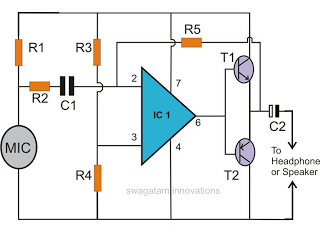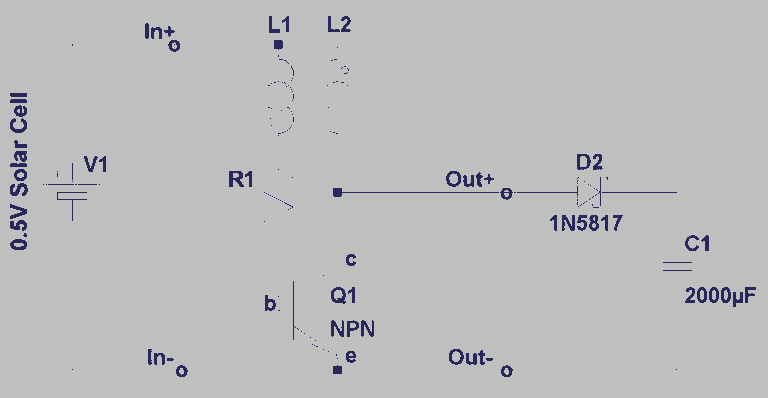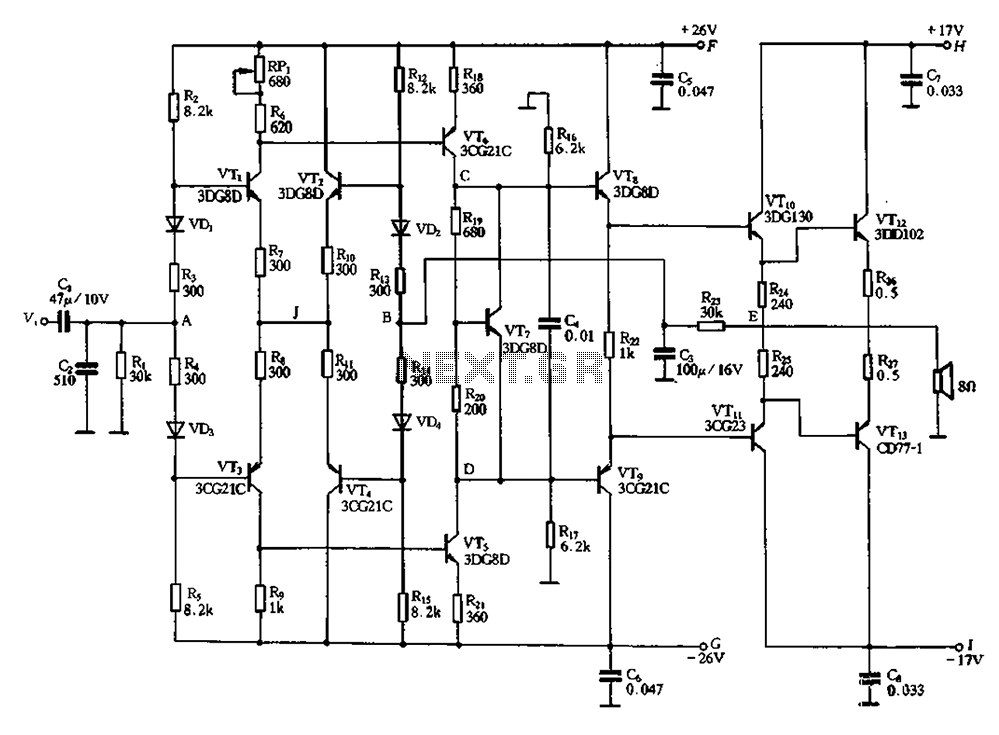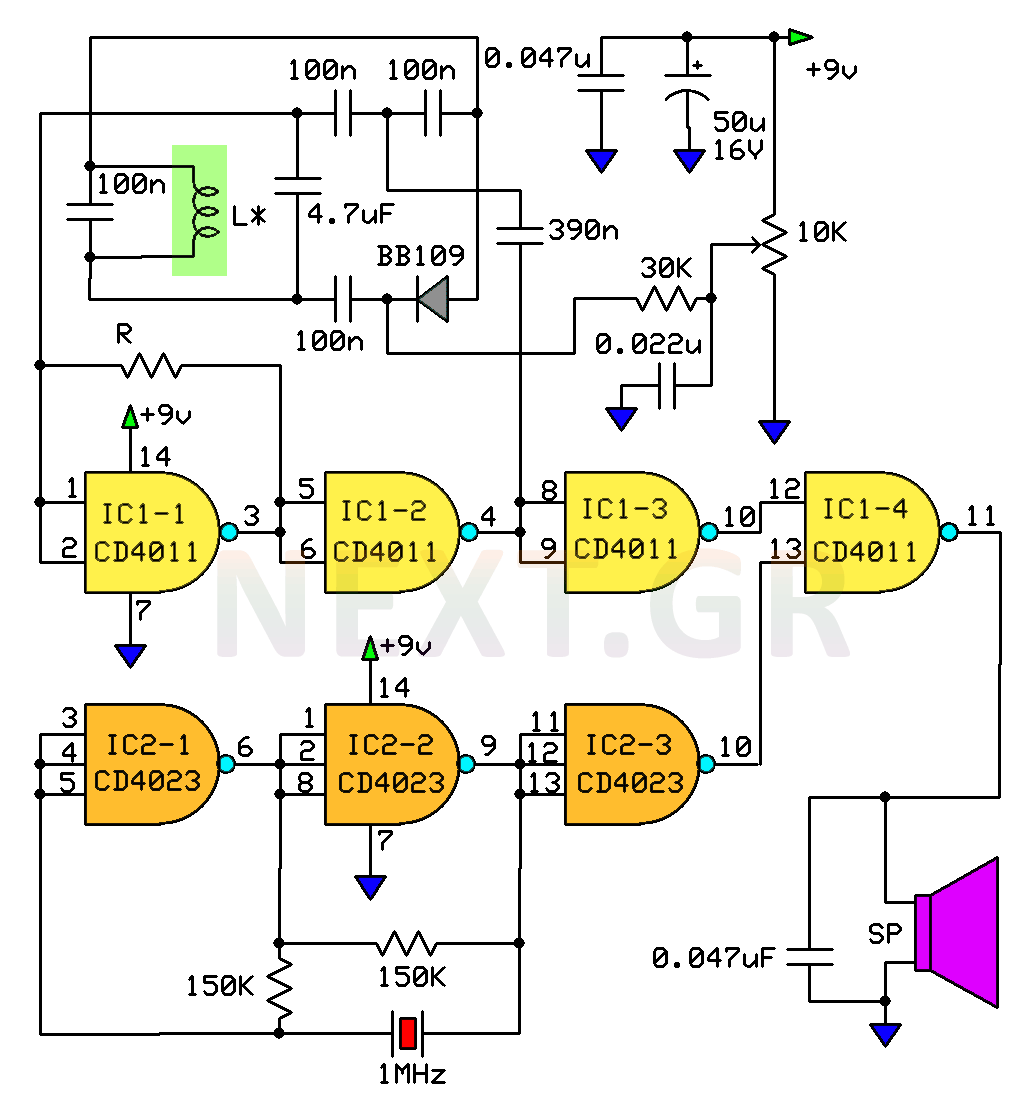
Electronic Spy Bug Circuit

This document discusses the creation of an electronic spy bug circuit using two methods: one involving a wired connection from the transmitter to the receiver, and the other being a completely wireless setup capable of eavesdropping on conversations up to a distance of approximately 30 meters, utilizing a standard FM radio. The circuit primarily functions as a high-gain amplifier, featuring the IC 741 as its core component, along with several high-gain output transistors. The IC 741 is configured as a non-inverting amplifier, serving as a pre-amplifier stage. The gain of this pre-amplifier can be adjusted as needed by using a potentiometer connected across its input and output pins. This gain setting is crucial for adjusting the amplifier's sensitivity, typically set to maximum to capture even low-volume speech. The microphone at the input converts sound vibrations into small electrical signals, which the IC 741 amplifies to appropriate levels before sending them to the output amplifier stage, which utilizes a standard push-pull configuration. The goal of this circuit is to detect weak sound signals or overhear hidden conversations; however, in this case, the captured audio signals are transmitted wirelessly rather than through wired connections. The operating frequency is influenced by the placement and values of components such as inductors and capacitors (C1, C2, C3), with adjustments to coil turns and dimensions optimizing the response for the FM receiver. A small antenna, approximately 3 inches in length, may be connected at a designated point to enhance the bug's responsiveness and produce distortion-free signals. The speaker, used as the receiver for the 741 circuit, can be placed in a different room where eavesdropping is intended. The connection between the amplifier circuit and the speaker should be made using thin wires, concealed along the entire length, potentially hidden under carpets or along room edges. For the wireless circuit, the process is simplified by concealing the transmitter circuit in a suitable location, such as under a table or couch.
The electronic spy bug circuit serves as an innovative solution for capturing audio signals discreetly. The use of the IC 741 as a non-inverting amplifier allows for effective amplification of low-level audio signals, making it suitable for various applications, including surveillance and monitoring. The circuit's design emphasizes flexibility, with the gain being adjustable via a potentiometer, thus enabling customization based on specific environmental noise levels and desired sensitivity.
In the wired configuration, the integration of the microphone and the push-pull output stage ensures that the captured audio is amplified adequately before transmission. The careful selection of components such as capacitors and inductors is vital for tuning the circuit to the desired frequency range, ensuring optimal performance with minimal distortion. The inclusion of a small antenna further enhances the circuit's ability to transmit clear audio signals over the FM band, which is crucial for effective eavesdropping.
In the wireless setup, the transmitter's concealment is critical for maintaining the circuit's stealthiness. Locations such as under furniture or in other discreet areas can help avoid detection while still providing effective audio capture and transmission. This flexibility in installation is a significant advantage of the wireless method, allowing for a broader range of applications in surveillance tasks.
Overall, this electronic spy bug circuit exemplifies the intersection of audio engineering and circuit design, offering a practical tool for capturing and transmitting audio signals in various environments. The careful consideration of component selection, circuit configuration, and installation techniques contributes to the overall effectiveness of the device in fulfilling its intended purpose.Here we`ll discuss how to make an electronic spy bug circuit using two methods, one that consists of wire link from the transmitter to the receiver, and the other which is completely wireless and can be used to eavesdrop a particular conversation over a range of about 30 meters, over an ordinary FM radio. The circuit is basically a high gain ampli fier using the IC 741 as the heart of the circuit and also a couple of high gain output transistors. The IC 741 if configured as a non inverting amplifier which performs the function of a pre-amplifier stage. The gain of this IC 741 preamplifier stage may be varied as desired, using the pot across its input and output pin outs.
The gain setting is used to set the sensitivity of the amplifier and is set to maximum so that even low volume speech conversation may be picked through it. The mic at the input transforms sound vibrations into minute electrical pulses, which is further amplified by the IC 741 to suitable levels before applying it to the output amplifier stage consisting of a standard push-pull stage.
The purpose of this circuit is also the same as above, that is for catching weak sound signals or for hearing some hidden conversation, however the caught voice signals here is transmitted into the air instead of forwarding it through wire links. The frequency mainly depends on the positioning and the values of the inductor, C1, C2 and C3. The coil turn distance and diameter may be manipulated a little for optimizing best response over the FM receiver.
A small antenna in the form of a 3 inches wire may be attached at the shown point for making the bug highly responsive and generate distortion free signals. For the 741 circuit, the speaker is only positioned and used as the receiver and may be placed in some other room, where the eavesdropping may be intended to be carried out.
The linking of the speaker from the amplifier circuit may be done through wire connections, preferably by using thin wires and escorting the entire length up to the speaker in some hidden way, probably by laying it under the carpet or across the corners of the room. For the wireless circuit everything becomes pretty simple and you just have to hide the transmitter circuit in some suitable place, like under the table, couch, sofa etc.
🔗 External reference
The electronic spy bug circuit serves as an innovative solution for capturing audio signals discreetly. The use of the IC 741 as a non-inverting amplifier allows for effective amplification of low-level audio signals, making it suitable for various applications, including surveillance and monitoring. The circuit's design emphasizes flexibility, with the gain being adjustable via a potentiometer, thus enabling customization based on specific environmental noise levels and desired sensitivity.
In the wired configuration, the integration of the microphone and the push-pull output stage ensures that the captured audio is amplified adequately before transmission. The careful selection of components such as capacitors and inductors is vital for tuning the circuit to the desired frequency range, ensuring optimal performance with minimal distortion. The inclusion of a small antenna further enhances the circuit's ability to transmit clear audio signals over the FM band, which is crucial for effective eavesdropping.
In the wireless setup, the transmitter's concealment is critical for maintaining the circuit's stealthiness. Locations such as under furniture or in other discreet areas can help avoid detection while still providing effective audio capture and transmission. This flexibility in installation is a significant advantage of the wireless method, allowing for a broader range of applications in surveillance tasks.
Overall, this electronic spy bug circuit exemplifies the intersection of audio engineering and circuit design, offering a practical tool for capturing and transmitting audio signals in various environments. The careful consideration of component selection, circuit configuration, and installation techniques contributes to the overall effectiveness of the device in fulfilling its intended purpose.Here we`ll discuss how to make an electronic spy bug circuit using two methods, one that consists of wire link from the transmitter to the receiver, and the other which is completely wireless and can be used to eavesdrop a particular conversation over a range of about 30 meters, over an ordinary FM radio. The circuit is basically a high gain ampli fier using the IC 741 as the heart of the circuit and also a couple of high gain output transistors. The IC 741 if configured as a non inverting amplifier which performs the function of a pre-amplifier stage. The gain of this IC 741 preamplifier stage may be varied as desired, using the pot across its input and output pin outs.
The gain setting is used to set the sensitivity of the amplifier and is set to maximum so that even low volume speech conversation may be picked through it. The mic at the input transforms sound vibrations into minute electrical pulses, which is further amplified by the IC 741 to suitable levels before applying it to the output amplifier stage consisting of a standard push-pull stage.
The purpose of this circuit is also the same as above, that is for catching weak sound signals or for hearing some hidden conversation, however the caught voice signals here is transmitted into the air instead of forwarding it through wire links. The frequency mainly depends on the positioning and the values of the inductor, C1, C2 and C3. The coil turn distance and diameter may be manipulated a little for optimizing best response over the FM receiver.
A small antenna in the form of a 3 inches wire may be attached at the shown point for making the bug highly responsive and generate distortion free signals. For the 741 circuit, the speaker is only positioned and used as the receiver and may be placed in some other room, where the eavesdropping may be intended to be carried out.
The linking of the speaker from the amplifier circuit may be done through wire connections, preferably by using thin wires and escorting the entire length up to the speaker in some hidden way, probably by laying it under the carpet or across the corners of the room. For the wireless circuit everything becomes pretty simple and you just have to hide the transmitter circuit in some suitable place, like under the table, couch, sofa etc.
🔗 External reference





